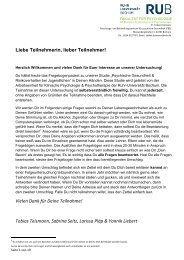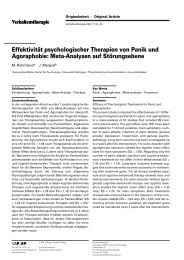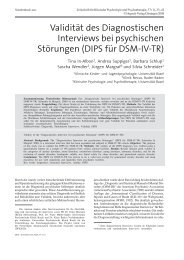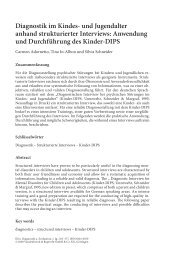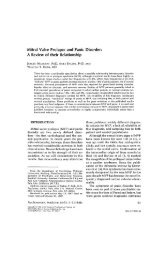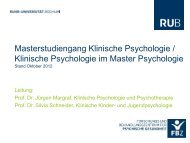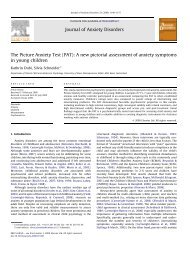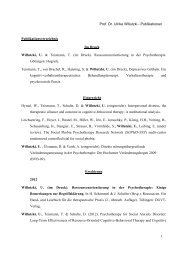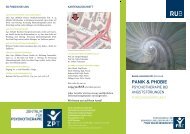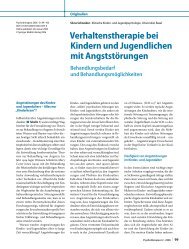Metacognitive Therapy versus Exposure and Response Prevention ...
Metacognitive Therapy versus Exposure and Response Prevention ...
Metacognitive Therapy versus Exposure and Response Prevention ...
You also want an ePaper? Increase the reach of your titles
YUMPU automatically turns print PDFs into web optimized ePapers that Google loves.
Table 2. Demographic <strong>and</strong> clinical<br />
characters of the two treatment groups<br />
Sample ERP MCT U p (2-tailed) 1<br />
Sex: m/f 4/1 2/3<br />
Age, years: Md, M, SD 14.08<br />
13.39<br />
3.06<br />
IQ score: Md, M, SD 90.00<br />
99.40<br />
25.06<br />
Duration, months: Md, M, SD 3.00<br />
9.80<br />
14.68<br />
CY-BOCS: Md, M, SD<br />
Range: 0–40<br />
CDI: Md, M, SD<br />
T score<br />
20.00<br />
17.00<br />
6.28<br />
50.00<br />
47.80<br />
9.68<br />
15.33<br />
14.53<br />
3.09<br />
106.00<br />
105.50<br />
9.88<br />
5.00<br />
5.60<br />
4.15<br />
26.00<br />
27.00<br />
5.87<br />
53.00<br />
51.20<br />
5.89<br />
8.0 0.347<br />
8.0 0.624<br />
12.5 1.000<br />
2.00 0.032*<br />
9.5 0.528<br />
1<br />
Mann-Whitney U-Test.<br />
Alpha level 0.05. Md = median; M = mean; SD = st<strong>and</strong>ard deviation; ERP = exposure<br />
with ritual prevention; MCT = metacognitive therapy; CY-BOCS = Children’s Yale-Brown<br />
Obsessive Scale; CDI = Child Depression Inventory (German version).<br />
The ERP treatment was similar to the published manual by<br />
March <strong>and</strong> Mulle [32] in combining ERP with narrative therapy.<br />
In contrast to this manual, however, no anxiety management techniques<br />
(such as relaxation training) were applied. In cases where<br />
the motivation for ERP began to decrease, home-based contingency<br />
management was added.<br />
MCT was based on techniques described by Salkovskis [10] <strong>and</strong><br />
Wells [11, 12] , adapted by the first author for children <strong>and</strong> adolescents.<br />
They were grossly comparable with already published cognitive<br />
interventions for adolescents with OCD [13–15] . The main<br />
differences between the two manuals were the interpretation of obsessions<br />
<strong>and</strong> the presumed working mechanism: in ERP, obsessions<br />
were conceptualized as meaningless <strong>and</strong> metaphorically described<br />
as ‘brain hiccups’ [32] . <strong>Therapy</strong> was explained to work by habituation.<br />
In MCT, obsessions were conceptualized as revealing the<br />
personal values <strong>and</strong> the deepest fears of the patient. <strong>Therapy</strong> aimed<br />
at challenging metacognitive appraisals (metacognitive restructuring)<br />
<strong>and</strong> changing metacognitive strategies (e.g. from suppressing<br />
thoughts to permitting/accepting them). Following Wells [12] , in<br />
this metacognitive framework ERP could be utilized as behavioral<br />
experiment intended to challenge dysfunctional metacognitions,<br />
but not in an intensive, repeated, or habituation-oriented manner.<br />
Accordingly, MCT patients were not encouraged to do ERP as<br />
homework. Details of the 5 MCT patients <strong>and</strong> their treatment can<br />
be seen in table 1 .<br />
Statistical Analysis<br />
Because of the small sample size only nonparametric tests were<br />
used. To examine the comparability of the two treatment groups,<br />
age, duration of complaints, IQ test scores, <strong>and</strong> the scores of the<br />
CY-BOCS <strong>and</strong> CDI before treatment were compared using the<br />
Mann-Whitney U test. The CY-BOCS total score as the primary<br />
outcome measure <strong>and</strong> the CDI T score were compared at pretreatment,<br />
post-treatment, <strong>and</strong> follow-up by calculating the nonparametric<br />
Wilcoxon paired rank sum test for every single treatment<br />
group. Using the Statistical Package for Social Sciences for Windows<br />
(SPSS) version 11.0, all hypotheses were examined at an alpha<br />
level of 0.05. Furthermore, the percentage of improvement <strong>and</strong> the<br />
effect sizes were evaluated using Cohen’s d [33] . Due to the small<br />
sample size, the effect sizes were corrected as recommended by<br />
Hedges <strong>and</strong> Olkin [34] .<br />
Results<br />
Comparability of the Treatment Groups<br />
Both treatment groups were comparable regarding<br />
their age, duration of complaints, IQ test scores, <strong>and</strong> depression<br />
scores ( table 2 ). The patients in the MCT condition<br />
had significantly higher CY-BOCS scores before<br />
treatment.<br />
Treatment Effects<br />
All patients showed a significant decrease in OCD<br />
symptom severity from pre- to post-treatment assess-<br />
260<br />
Psychother Psychosom 2006;75:257–264<br />
Simons /Schneider /Herpertz-Dahlmann



